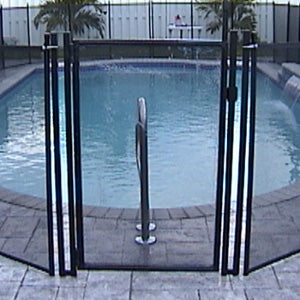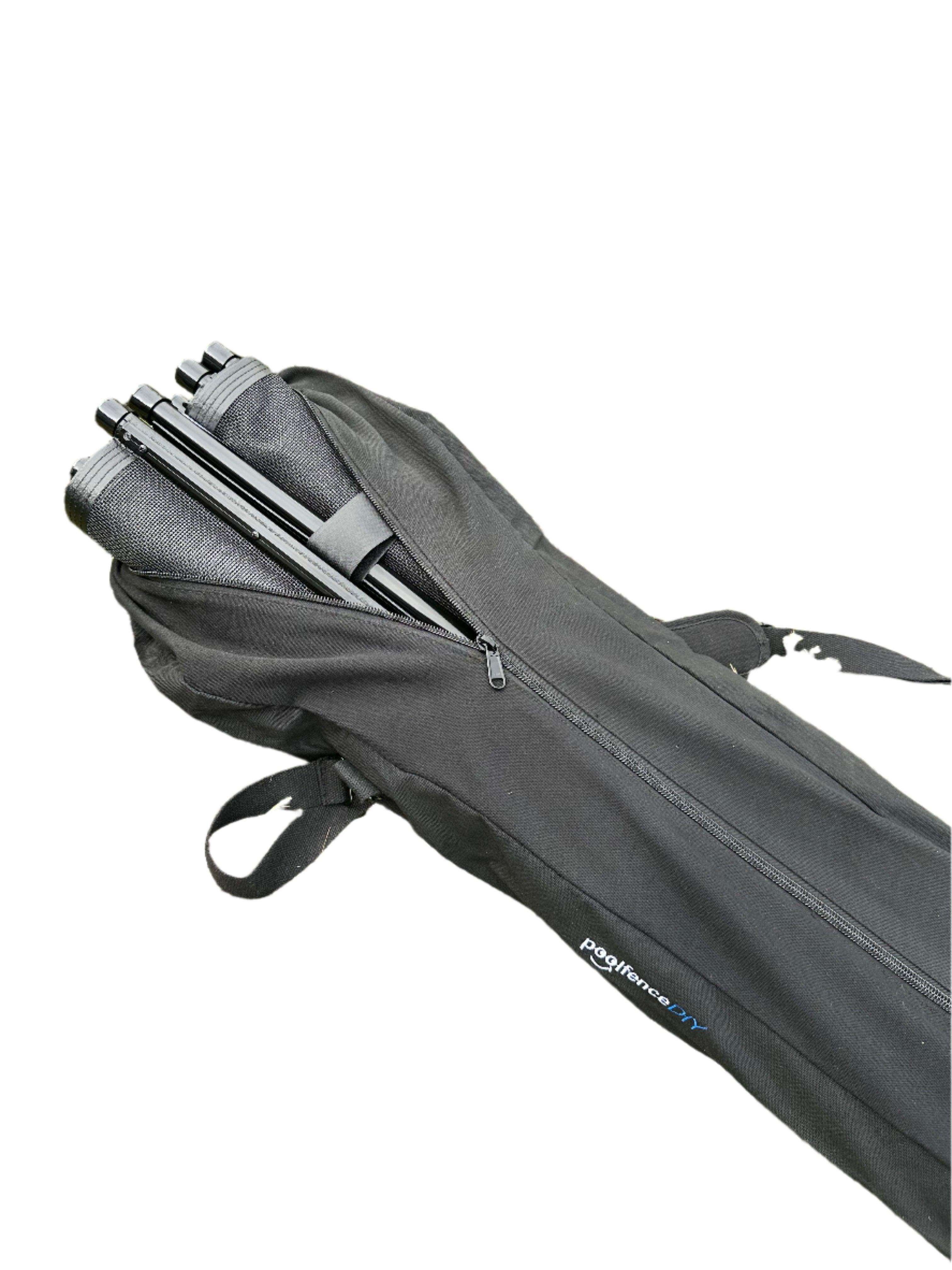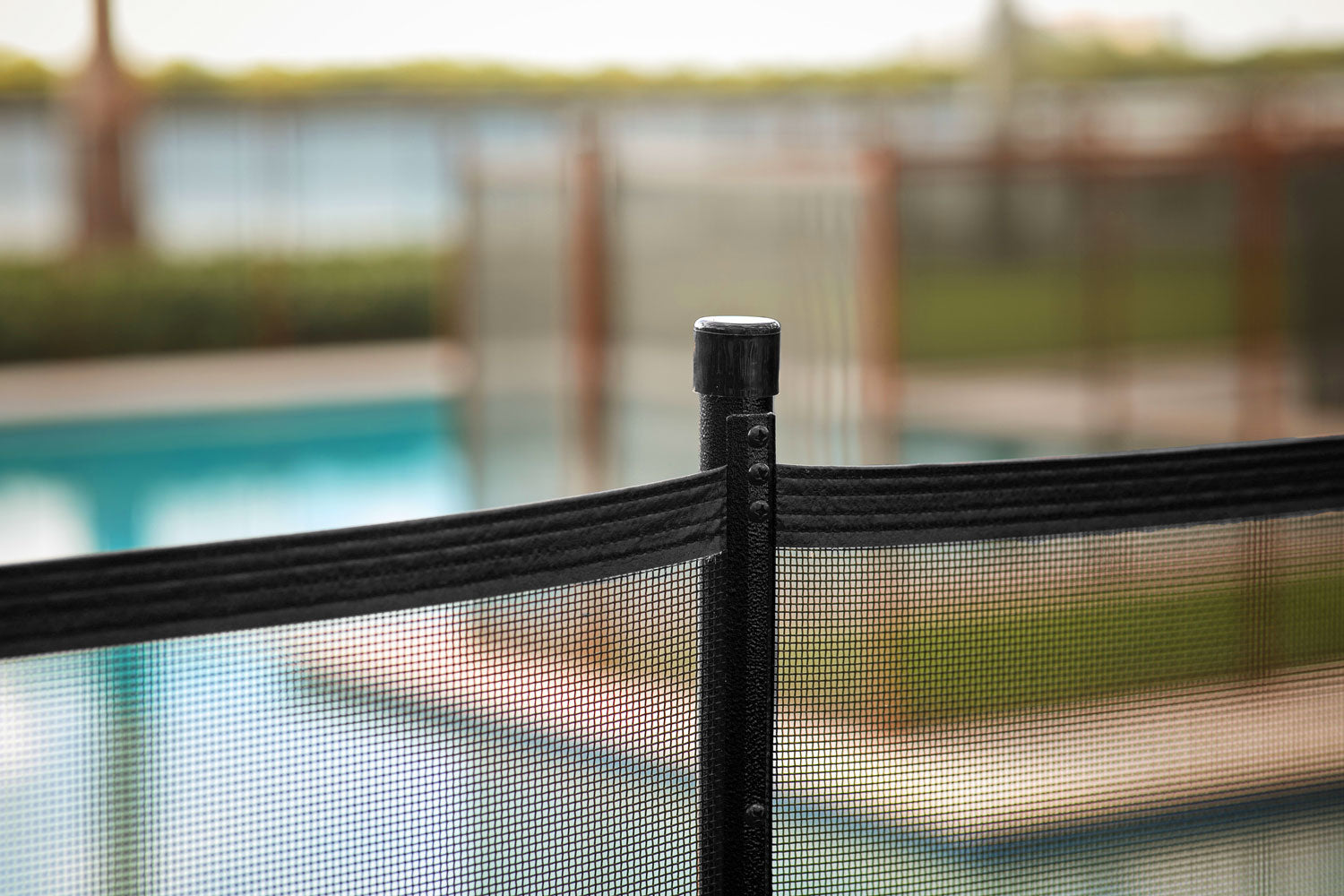Wood Deck Installation
Installing a Pool Fence DIY in a wood deck is similar to installing in pavers on sand/crushed stone in that drilling it out and setting plastic sleeves directly into the wood will not provide sufficient support. What you need to do is add wood blocks underneath every hole you drill. After installing the wood supports you can then drill out and set plastic sleeves in as usual.
To install the wood supports simply follow these steps:
Mark-Out Pool
First mark out the pool as if marking out for a regular concrete deck job.
Add Wood Supports
Next you will need to add your wood supports underneath every mark you have drawn. There are three ways of doing this:
-
The first way, and the most common way is to pull up the board next to or parallel to the marked board/s.
- Carefully tap a piece of angle iron (See Fig. 31) in between the deck boards.

- Using a hammer, tap a pry bar between the board and the angle iron enough so that the pry part of the pry bar is underneath the board. Then carefully and slowly pry the board up until the nails release from the first support beams underneath the deck. (See Fig. 33)

- Now take a second pry bar and walk the board up the rest of the length. (See Fig. 34) (When dealing with rotted wood, at the first sound of the board cracking or splitting, it is a good idea to just put it back down and choose another board or be prepared to replace the deck boards. If when you do the estimate and notice the customers deck boards are rotted and can potentially crack while pulling them up make the customer aware and include charges in the estimate for board replacement if necessary.)

- Once all the boards are pulled up now you can block. The ideal size of a wood block should be a 2" X 6" cut into 8" lengths. (See Fig. 32) The ideal wood to use is CCA, pressure treated, or 30 year wood. Do not use regular wood. It will most likely rot out before warranty is up. There are three ways of positioning the block. In all cases it is to ensure that the block will cover the entire area underneath the marked hole.

- The main way of positioning the block is called Fat Ways (See Fig. 35a) (or lying the block with the 4" side flush with the bottom of the deck board). This works when the marked hole is on a board with no support beams underneath the marked hole itself.
- The second way of positioning a wood block is Skinny Ways. (See Fig. 35b) This style of blocking is used when your marked hole is half over a support beam and half not. The third way is 2 Skinny. (See Fig. 35c) You use this blocking technique when you have a double hole surrounding a beam or one hole half on the support and the second hole is not. The Skinny technique is used to prevent the spade bit from skipping out after drilling through the wood block.
- Once you have determined the necessary positioning of the block for the application you can then sink two 3" galvanized, stainless, or coated screws through the deck board and into the block. It is a good idea to counter sink all screws. Also counter the screws in the block so that the block won't split and/or crack off. (See Fig. 35)

- Now all your holes are blocked you can replace your deck boards exactly how they were and drill out the fence. With the wood supports you can treat the job as though it were installed in concrete and set regular plastic sleeves into the deck.
- Carefully tap a piece of angle iron (See Fig. 31) in between the deck boards.
-
The second way of blocking is the easiest but in most cases not possible. It requires access underneath the deck. This works best when you have a helper with you.
- Mark out deck as usual. Then drill out the deck once. This allows for the man underneath the deck to see how he needs to position the block and where. Once block/s are in position the man on the top of the deck screws down into the block. Next drill out the deck for the second time, sleeve with plastic and you are done.
-
The third way of blocking is referred to as Snaking. This is the most difficult way but is necessary when you can not block because: The deck planks are so tight together you can not fit a pry bar between, the deck is made of an expensive wood such as mahogany and you are afraid to damage it, there is no room to get underneath, the deck boards are so rotten that pulling them up will guarantee their breakage and the customer does not want to pay for board replacement.
- Similar to the (2) second way of blocking, you will mark out your fence and then drill it before blocking.
- This technique is also easier if you have two men. You will need an electrician's snake and some pool fence eyelets.
- Feed the snake into the hole you drilled to the outside of the deck. Choose the shortest easiest route to the outside of the deck to avoid getting hung up on the support beams underneath. (See Fig. 36)
- Once you have fed the snake to the outside area of the deck, take a block and screw an eyelet into the block in such a way so that when you pull the block back underneath the deck and up to the hole, the eyelet will come through the hole you drilled and the block will cover the entire area. (See Fig. 36a and 36b)

- The man holding the snake will pull firmly up on the snake while the other man screws down into the block. (See Fig. 37a and b) When all holes are blocked, drill out for a second time and sleeve with plastic sleeves. Sometimes a combination of all three of these blocking techniques are needed to add wood supports on a job.

Design Your Own Pool Fence
Calculator Step 1 of 14
Installing a Complete or Partial Fence?
Will your fence go completely around the pool, or will you be attaching it to an existing wall or barrier?
Fence will go completely around the pool
Fence will be attached to existing fence or wall


Calculator Step 2 of 14
Fence Height
($9.88 / foot)

*MOST POPULAR*
($15.33 / foot)

*Meets California code*
Calculator Step 3 of 14
Fence Color


Calculator Step 4 of 14
Total Fence Length
What is the total length in feet you will need for your fence?
If your fence will be completely in a hard surface, e.g. concrete, thick wood, tiles over concrete or a hard subsrate, stone, etc., leave the number of feet over grass as "0" and vice versa.
If your fence will be partly in a hard surface and partly in grass, enter the total number of feet of fence you will need in each surface into the two fields below.
Calculator Step 5 of 14
Arched or Flat Top Gate
Your self-closing gate can either have the standard flat top or be upgraded to an arched top.


Calculator Step 6 of 14
Self-Closing, Self-Latching Gates
How many self-closing, self-latching gates would you like?
Gates that will be in a hard surface
Gates that will be in grass/dirt
The Pool Fence DIY system includes a manual opening at no charge. Self-closing, self-latching gates are recommended by everyone from the American Academy of Pediatrics to the Consumer Product Safety Commission to the National Drowning Prevention Alliance. Besides being safer, they are also MUCH more convenient. A must if you have older children who use the pool.
Calculator Step 7 of 14
90° Turn Posts
Are you making any 90° turns? If yes, how many?

Calculator Step 8 of 14
Accessories
This item is HIGHLY recommended to ensure the fence is properly installed.
Will you need the Pool Fence DIY Drilling Guide with Bubble Level?
$0.00 $122.56

Calculator Step 9 of 14
Rotary Hammer Drill
The Pool Fence DIY Rotary Hammer Drill is the recommended hammer drill for installing this style of mesh pool fencing. Having the right tool for the right job makes installation go smoother. It also comes with a 16" long x 5/8" diameter drill bit, which is the recommended bit for this installation and is the correct length for the Pool Fence DIY Drill Guide, which is highly recommended.
$217.99 $173.61
Sorry, item currently out of stock.

Calculator Step 10 of 14
Drill Bits
Do you need the correct bit for your hammer drill (or an extra bit)?
Pool Fence DIY SDS-Plus Masonry Bit 5/8th Inch Diameter by 16 Inch Length (compatible with the Pool Fence DIY Rotary Hammer Drill)
Pool Fence DIY Standard (Smooth Shank) Masonry Bit 5/8th Inch Diameter by 16 Inch Length (for non-SDS compatible hammer drills)
$21.98 each

$21.35 each

Calculator Step 11 of 14
Do you want storage bags for your fence sections?
Our Pool Fence Section Storage Bag offers a reliable and convenient way to store and transport your fence sections. Each bag is designed to hold two 4-foot sections and includes two smaller straps to wrap each section securely, keeping everything compact and ready for storage. Made from heavy-duty canvas with a strong zipper, this bag is built for durability. Rubber pads on the bottom prevent canvas wear and slipping when the bag is stood on end. With a comfortable shoulder strap for easy carrying, this storage bag is an ideal choice for off-season storage or anytime your pool fence is not in use.
$39.00 each
Sorry, item currently out of stock.

Calculator Step 12 of 14
How many Solar Lights do you want on your fence?
$10.22 each
Quantity:


Calculator Step 13 of 14
Do you want to add Omni-Hangers to your fence?
How many two-packs you would like with your fence?
$25.24 per two-pack
Quantity:




